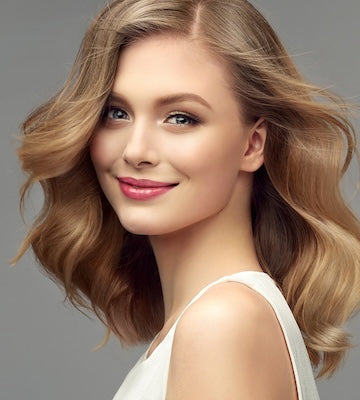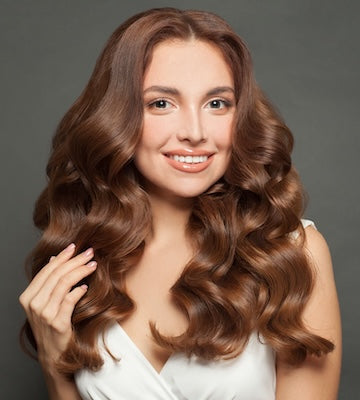Underlying causes and effective solutions
Menopause can bring surprising changes to your hair, like thinning, shedding or changes in texture. If you’re noticing these changes, you’re not alone, it’s mainly due to hormonal shifts. But understanding what’s happening will help you look after your hair during this time.
When menopause starts, it often brings changes in areas we don’t always expect—like our hair. If you've started noticing more hair in your brush or your hair feels thinner and lacking its usual bounce, it’s all part of the hormonal changes your body is going through.
But understanding the science behind these changes and how long each phase might last will help you take control and support your hair through this time. So, let’s dive into everything you need to know about menopausal hair loss and changes, from perimenopause to postmenopause, and how you can help your hair through it all.
Does menopause cause hair loss?
So, does menopause change the texture of hair? And does it cause hair loss? The short answer is yes. It absolutely can.
Menopause hair loss is often caused by hormonal changes in your body. When estrogen levels drop, your hair follicles can become smaller, which makes it harder for your hair to grow as thick and full as it once did. You might also notice changes in texture, your hair might feel finer, drier or frizzier. Again, this is mainly due to the reduction in estrogen, which plays a major role in maintaining the growth phase of the hair cycle.
The menopausal transition period varies between women, lasting anywhere from a few months to a decade. This transition begins with perimenopause (the time leading up to menopause) and typically concludes when you’ve gone 12 months without a period. When that happens, you’ve officially entered menopause and start a new phase in your life. And yes, that includes some hair changes.
But knowing what to expect can help you make informed decisions on keeping your hair in top shape.
The main changes women report include:
-
Hair loss: Some women experience significant hair shedding due to hormonal shifts, particularly a drop in estrogen and progesterone
-
Hair thinning: Hair may appear less voluminous as individual strands become finer
-
Slower growth rate: Hair may take longer to grow, contributing to the feeling of thinner, less healthy locks
-
Dry hair: Reduced oil production in the scalp can leave hair feeling dry and rough
-
Brittle hair: Hormonal changes can weaken hair, leading to breakage and split ends
-
Changes in texture: Someone with sleek, straight hair all their life might suddenly find their hair wavy, frizzy or coarse. This is because hormonal fluctuations affect the structure of hair follicles
-
Increased greying: The natural ageing process often accelerates during menopause, leading to a more noticeable appearance of grey or white hair
-
Scalp sensitivity: Thinner skin and reduced oil production can make the scalp more prone to dryness and irritation
-
New growth patterns: Some women notice an increase in facial hair due to higher androgen levels. Menopausal pubic hair loss is also common, as hormonal changes reduce hair density in areas other than the scalp
Menopausal hair loss and hair thinning
Let’s start with this: it’s completely normal to feel unsettled if you notice more hair shedding than usual. For many of us, our hair is deeply tied to how we feel about ourselves, and it’s not just about appearance, but confidence too. So experiencing changes like thinning or shedding during menopause can feel like a big adjustment.
But understanding why this happens can empower you to take steps toward feeling more in control.
Here’s what’s going on.
Hair loss during perimenopause
The journey to menopause starts with perimenopause. You might experience symptoms of menopause but still have periods. This is when estrogen and progesterone levels fluctuate, and these hormonal shifts can make your hair thinner.
How long does perimenopause and hair loss last?
Perimenopause can last anywhere from a few months to ten years. During this time, your estrogen levels may gradually decline, which causes your hair to shed more easily and enter the resting phase of the hair cycle. You might notice hair thinning especially around the crown or temples.
For some women, hair thinning during perimenopause is subtle. It might be just more hair in the shower. For others, it’s more pronounced and may even result in short, broken hair or balding patches.
Unlike menopause and postmenopause, where hormone levels stabilise at low levels, perimenopause is marked by unpredictability, with estrogen and progesterone levels rising and falling. These fluctuations (similar to postpartum hormone shifts) uniquely affect your hair.
What causes hair loss during perimenopause?
1. Fluctuating estrogen levels
-
Rises in Estrogen: Temporary spikes in estrogen may delay the hair’s transition from the anagen (growth) phase to the telogen (resting) phase, creating periods of minimal hair loss
-
Declines in Estrogen: Drops in estrogen cause hair follicles to shift into the telogen phase, leading to increased shedding. This inconsistency can make hair loss feel unpredictable during perimenopause
2. Progesterone’s decline
-
Progesterone levels tend to decrease earlier and more steadily than estrogen. This imbalance heightens the effect of androgens (male hormones) like testosterone
-
Androgens can lead to smaller hair follicles, especially around the temples, crown and front of the scalp. This results in finer, weaker hair
3. Stress hormones and lifestyle
- Hormonal unpredictability can heighten stress levels, which in turn increases cortisol production. High cortisol can disrupt hair growth, pushing more follicles into the telogen phase
-
Nutritional deficiencies and problems with sleep (also common perimenopause symptoms), can exacerbate hair thinning

Hair loss during menopause
Menopause officially kicks in once you’ve gone 12 months without a period. At this time, hair loss during menopause can become more noticeable. Many women also experience increased hair thinning, where hair doesn’t hold its shape the way it used to, seeming limp or less voluminous. Again, it’s all part of your body adjusting to hormonal changes.
What causes hair loss during menopause?
It’s the drop in estrogen and progesterone that’s mainly responsible for hair loss during menopause. These hormones play a critical role in hair health (as well as plenty of other important functions). But in short, as estrogen decreases, your hair follicles shrink, making it harder for hair to grow thick and full. The fall in progesterone can also lead to more shedding and thinning hair in menopause.
The underlying factors are the same as perimenopause, but hair loss is more pronounced due to the steadier shifts in hormones:
-
Estrogen and hair growth: Estrogen helps keep hair in the anagen (growth) phase, which promotes thicker and fuller hair. As estrogen levels rapidly drop during menopause, hair follicles spend less time in the growth phase and transition more quickly to the telogen (resting) phase. This shift results in increased hair shedding and finer, drier hair
-
Progesterone’s role: Progesterone complements estrogen by balancing its effects and supporting overall scalp health. A decrease in progesterone exacerbates hair thinning, as the hormonal balance tips towards androgens (male hormones like testosterone)
-
Androgenic influence: The decline in estrogen and progesterone often leads to a relative increase in androgen activity. Androgens, particularly dihydrotestosterone (DHT), can shrink hair follicles, a process known as “miniaturisation”. This makes it harder for new hairs to grow, leading to thinning, especially along the hairline and crown
-
Stress hormones: Menopause can be a stressful time physically and emotionally, which may elevate cortisol levels. Chronic stress and high cortisol disrupt the hair growth cycle, causing more hair follicles to enter the telogen phase prematurely
-
Nutritional factors: Hormonal changes during menopause may also impact nutrient absorption and metabolism. Lower estrogen can impair the body’s ability to absorb iron, vitamin D, and biotin, all of which are crucial for healthy hair growth
Your hair might feel especially fragile during menopause, and it’s natural to find this challenging. But remember, you’re not alone in this journey. So many women experience these changes, and they don’t last forever. You’re getting closer to a time when things will begin to feel more settled.
Hair loss after menopause
Even after you’ve passed through the menopause itself, you might still notice thinning. Hair loss after menopause continues as your estrogen levels remain low. While the changes might not be as dramatic as during the initial transition, postmenopausal hair loss is still common.
After menopause, hair changes tend to stabilise but may still progress due to the cumulative effects of hormonal changes, ageing and lifestyle factors. This means that while hair thinning slows, it can continue.
What causes hair loss after menopause?
Here are the main factors behind the changes:
-
Low estrogen levels persisting: Once menopause is over, estrogen levels stabilise but remain significantly lower than premenopausal levels. Since estrogen is crucial for keeping hair in the anagen (growth) phase, hair continues to grow more slowly and thin more easily
-
Androgens remain influential: The relative dominance of androgens, like testosterone, becomes more pronounced post-menopause. These androgens can be converted into dihydrotestosterone (DHT), a hormone known to miniaturize hair follicles—especially on the crown and front of the scalp. This process often leads to thinning hair after menopause
-
Aging and follicular changes: Ageing plays a role in postmenopausal hair changes. The hair follicles may shrink naturally with age and the melanin production decreases, making hair finer and more brittle. Additionally, the scalp may produce less oil, leading to drier and more fragile hair
Although your hair’s natural density and thickness may not fully return to its premenopausal state, there’s plenty you can do to nurture its health. As well as consistent care and the right treatments, bespoke hair extensions can help your hair look vibrant and full of life. This new phase of life is about finding what works for you, and your hair can be an important part of that journey.
How to prevent hair loss in menopause
There’s no doubt that hair loss can be unsettling, but the good news is there are menopause hair loss treatments to help you feel more confident and supported during this stage. No single solution works for everyone, and it’s okay to try different approaches until you find what feels right.
Whether it’s through nutrition, vitamins for postmenopausal hair loss, or a few lifestyle tweaks, the key is focusing on what helps you feel your best as you navigate this new stage. While everyone’s menopause experience is unique, exploring these options could help you maintain healthy, vibrant hair.
1. Vitamins and nutrients for hair health
What vitamins are good for menopause hair loss? Well, vitamins like biotin, vitamin D and zinc are often recommended for their benefits to hair growth and strength. Supplements containing omega-3 fatty acids or vitamin B complex also nourish your hair from the inside out. If you suspect a deficiency is behind hair thinning, speaking with a healthcare professional could be a helpful first step.
2. Dietary adjustments
As well as vitamins, a nutrient-rich diet can support hair health during menopause. Foods high in protein, iron and omega-3 fatty acids—such as salmon, eggs and nuts—may provide the building blocks your hair needs to stay strong. You might also consider discussing your diet with a nutritionist to ensure you’re getting everything you need.
3. Gentle hair care practices
Caring for thinning hair in menopause often means being mindful of your daily routine. Switching to gentle, sulfate-free shampoos and conditioners for thinning hair can reduce breakage. Minimising heat styling, adopting gentle hairstyles and using soft towels after a shower will reduce stress on fragile hair.
4. Hair extensions for added volume
Hair extensions are worth exploring if you’re looking to add overall volume or fill in thinning areas. High-quality, bespoke products (like our Phoenix Crown range), provide lightweight extensions tailored to specific areas like the crown, temples, or all-over volume. Blending seamlessly with your natural hair, extensions offer a subtle yet transformative way to enhance your look without straining your scalp.
5. Topical treatments for hair regrowth
If regrowth is your goal, topical menopause hair loss treatments like minoxidil could be worth exploring. These products work by improving scalp circulation and stimulating hair follicles. While results vary, many women find that incorporating a targeted treatment into their routine encourages new hair growth and improves thickness over time.
6. Hormone Replacement Therapy (HRT)
HRT can be a valuable option for managing menopausal symptoms. By replenishing estrogen levels, it may help slow hair thinning and shedding. However, before jumping into HRT for hair loss, it’s important to consult with your doctor. As for some women, HRT can actually exacerbate symptoms like hair thinning.
7. Managing stress
Stress is known to affect hair health, so finding ways to manage it can be helpful. Activities like yoga, meditation or a daily walk can lower cortisol levels and promote overall well-being. Identifying small moments of relaxation in your day may also create a positive ripple effect for both body and mind.
Menopausal hair loss: in summary
Menopause may bring changes to your hair, but it doesn’t have to mean losing your confidence. By understanding what’s happening in your body and how long these phases might last, you can feel more empowered to take proactive steps.
Whether it’s tackling hair loss during perimenopause, adjusting your diet to manage menopausal thinning, or supplementing your hair’s volume with discreet hair extensions, there are multiple options to help you feel in control. With the right care and approach, you can maintain healthy hair and embrace this new phase with confidence.
At Phoenix Crown, we’re here to help you feel confident and radiant because when you feel good, it shows. Our community-driven articles and research-backed insights are here to support your unique hair care journey. Discover our luxurious Virgin clip-in hair extensions and find solutions tailored just for you.










